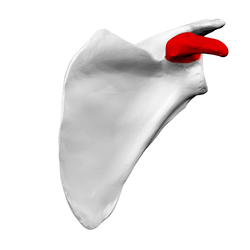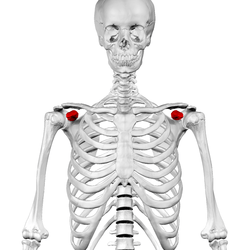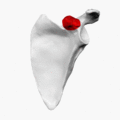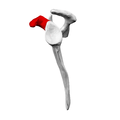Coracoid process
| Coracoid process | |
|---|---|
 Left scapula. Anterior view. Coracoid process shown in red. | |
 Anterior view. Coracoid process shown in red. | |
| Details | |
| Identifiers | |
| Latin | Processus coracoideus |
| TA | A02.4.01.023 |
| FMA | 13455 |
The coracoid process (from Greek κόραξ, crow) is a small hook-like structure on the lateral edge of the superior anterior portion of the scapula. Pointing laterally forward, it, together with the acromion, serves to stabilize the shoulder joint. It is palpable in the deltopectoral groove between the deltoid and pectoralis major muscles.
"Coracoid" in itself means "like a raven's beak", with reference to its shape. (Greek "Korax" = Raven)
Structure
The coracoid process is a thick curved process attached by a broad base to the upper part of the neck of the scapula; it runs at first upward and medialward; then, becoming smaller, it changes its direction, and projects forward and lateralward.
The ascending portion, flattened from before backward, presents in front a smooth concave surface, across which the Subscapularis passes.
The horizontal portion is flattened from above downward; its upper surface is convex and irregular, and gives attachment to the Pectoralis minor; its under surface is smooth; its medial and lateral borders are rough; the former gives attachment to the Pectoralis minor and the latter to the coracoacromial ligament; the apex is embraced by the conjoined tendon of origin of the Coracobrachialis and short head of the Biceps brachii and gives attachment to the coracoclavicular fascia.
On the medial part of the root of the coracoid process is a rough impression for the attachment of the conoid ligament; and running from it obliquely forward and lateralward, on to the upper surface of the horizontal portion, is an elevated ridge for the attachment of the trapezoid ligament. [1]
Function
It is the site of attachment for several structures:
- The pectoralis minor muscle - to 3rd, 4th and 5th rib.
- The short head of biceps brachii muscle - to Radial tuberosity.
- The coracobrachialis muscle - to medial humerus.
- The coracoclavicular ligament - to the clavicle. (The ligament is formed by the conoid ligament and trapezoid ligament.)
- The coracoacromial ligament - to the acromion
- The coracohumeral ligament - to the humerus
- The superior transverse scapular ligament - from the base of the coracoid to the medial portion of the suprascapular notch
Clinical significance
The coracoid process is palpable just below the lateral end of the clavicle (collar bone). It is otherwise known as the "Surgeon's Lighthouse" because it serves as a landmark to avoid neurovascular damage.[2] Major neurovascular structures enter the upper limb medial to the coracoid process, so that surgical approaches to the shoulder region should always take place laterally to the coracoid process.
Other animals
In monotremes, the coracoid is a separate bone. Reptiles, birds, and frogs (but not salamanders) also possess a bone by this name, but is not homologous with the coracoid process of mammals.[3]
Analyses of the size and shape of the coracoid process in Australopithecus africanus (STS 7) have shown that in this species it displayed a prominent dorsolateral tubercle placed more laterally than in modern humans. This reflect, according to one interpretation, a scapula positioned high on a funnel-shaped thorax and a clavicle positioned obliquely as in extant great apes. [4]
Additional images
 Left scapula. Coracoid process shown in red.
Left scapula. Coracoid process shown in red. Animation. Coracoid process shown in red.
Animation. Coracoid process shown in red. Left scapula. Lateral view. Coracoid process shown in red.
Left scapula. Lateral view. Coracoid process shown in red.
References
- ↑ Gray's Anatomy (1918), see infobox.
- ↑ Gallino, Mario; Santamaria, Eliana; Tiziana, Doro (1998). "Anthropometry of the scapula: Clinical and surgical considerations". Journal of Shoulder and Elbow Surgery. 7 (3): 284–291. doi:10.1016/S1058-2746(98)90057-X.
"...defined by Matsen et al. as 'the lighthouse of the shoulder.'
- Matsen, Frederick A; Lippitt, Steven B; Sidles, John A; Douglas T, Harryman (1984). Practical Evaluation and Management of the Shoulder. ISBN 978-0-7216-4819-4.
- ↑ Romer, Alfred Sherwood; Parsons, Thomas S. (1977). The Vertebrate Body. Philadelphia, PA: Holt-Saunders International. pp. 186–187. ISBN 0-03-910284-X.
- ↑ Larson, Susan G. (2009). "Evolution of the Hominin Shoulder: Early Homo". In Grine, Frederick E.; Fleagle, John G.; Leakey, Richard E. The First Humans - Origin and Early Evolution of the Genus Homo. Springer. pp. 65–6. doi:10.1007/978-1-4020-9980-9. ISBN 978-1-4020-9979-3.
External links
| Wikimedia Commons has media related to Coracoid process. |
- aplab - BioWeb at University of Wisconsin System
- Anatomy image: skel/scapula2 at Human Anatomy Lecture (Biology 129), Pennsylvania State University
